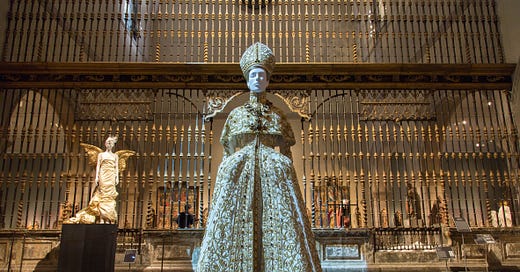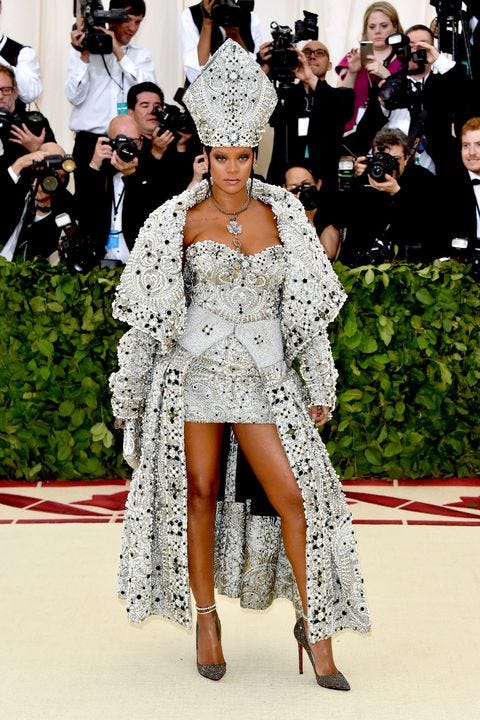Coffee Morning: The Gods of… Fashion? Anna Wintour meets the Pope
Here’s a little fun freebie to entice…
Grab a cuppa, a cake, and let’s chat.
But remember to sign up for the good stuff!
The Middle Ages—and particularly ‘Gothic’ —have been used as a crutch upon which to hinge the broader medieval period as a time of avarice, opulence, lawlessness, and barbarism (just take a look at recent headlines—you’ll see this aplenty), thereby repeatedly appropriating and repackaging the era into a ‘sexy’ yet rebellious age. This has served only to entice the media (and, by default, the general public) into spouting inaccuracies and misappropriations galore.
How has the ‘medieval’ in the ‘modern’ become so captivating and alluring yet equally illusory—and why? And how about the medieval church? Has it faced the same misperceptions? Short answer: you bet!
This concept was meted out at the Met Gala Ball a few years ago when stars donned attire inspired by the Catholic Church’s ‘Long Renaissance’ (commonly periodised as between 500 and 1550AD). It was difficult to miss the (no doubt, unintentional) irreverence of Rihanna’s glistening papal mitre (headdress) and chasuble (outer garment) designed by John Galliano. The pop-star was literally assuming (and might we even suggest, sexualising?) the supreme mantle of an institution which does not permit women to hold office. The irony writes itself but the design of the singer’s garb and her authoritative pose as she struts before the world’s press makes a very pointed statement against the patriarchy (you go, girl!).
The ball’s theme was an extension of the Met’s 2018 exhibition: Heavenly Bodies: Fashion and the Catholic Imagination. Oh, how times have changed: from gilded and crystal reliquary caskets and monumental shrines adorned with jewels and gems taking pride of place within their vibrant sacred enclosures, to celebrities dripping in vestment-like attire on media pilgrimages around the holy statues and religious artworks of stark white art galleries/museums.
‘The garments and ensembles on show represent the opulence and “pageantry” often associated with Catholicism.’
A similar case of “extending” medieval metaphors occurred when James Comey, the former F.B.I. director (during his testimony before the Senate Judiciary Committee), uttered the infamous antiquarian form of Henry II’s line in reference to Archbishop of Canterbury, Thomas Becket (the ‘meddlesome priest’ jibe: sorry, Henry never said that—a discussion for a future post), suggesting a powerful leader’s statements were tantamount to official orders, thereby offering himself up as a martyr to the cause (hmm). The use of the medieval church in this way has been widely discussed and is not dissimilar to previous assertions towards ‘Orientalism’: creating an ‘other’ to contrast with one’s own identity (the modern versus the medieval, or ‘West’ versus ‘East’), but which often leads to exoticization.
So, do these modern appropriations help our perception of the medieval church? Or, do they turn it into a pageant and therefore a mockery? Should we be draping ourselves in ecclesiastical-inspired costume?
I’m eager to read your thoughts below. And do pop your questions for me on this or anything at all there, too—I will respond in the next podcast.
Although this post is free to access, for more exclusive and varied content (articles, Q & As, interviews, listicles, reviews, tips on getting published, freebies, and podcast-style audio posts (and videos, perhaps)—as well as special guests popping by), please do consider subscribing. Your subscriptions allow this platform to survive—and this author!







Very insightful questions. Thank you. I’ll have a go at talking them through during the next audio episode.
I've just been on the website for a nearby Anglican church. Not a dog collar in sight on any of the "team photos". OK, they worship in a 1960s building so I'd be surprised if they were very medieval but it is still an nteresting contrast with this.